
Mitrovica, also referred as Kosovska Mitrovica, is a city in northern Kosovo and administrative center of the District of Mitrovica. In 2013, the city was split into two municipalities, South Mitrovica and North Mitrovica. Settled 10 km from Ujmani/Gazivoda Lake, on the confluence of the rivers Ibar, Sitnica, Lushta, and Trepça, the city is surrounded by the mountains of Kopaonik, Rogozna, Mokna, and Çyçavica. According to the 2011 Census, the two municipalities had 97,686 inhabitants of which 85,360 reside in south and 12,326 in north.

Kosovo District was a district of Kosovo and Metohija between 1990 and the end of the Kosovo War in 1999. From the Serbian point of view, the district continues to be part of the Republic of Serbia. It had a population of 672,292 and its capital was Pristina.

Ulpiana was an ancient Roman city located in what is today Kosovo. It was also named Justiniana Secunda. Ulpiana is situated in the municipality of Gračanica, 12 km to the southeast of Pristina. The Minicipium Ulpiana - Iustiniana Secunda was proclaimed archaeological park under permanent protection of Kosovo by the Kosova Council for Cultural Heritage in 2016. The Archaeological Park has a surface of 161.10 hectares and a surrounding protection zone of 96.23 hectares. Ulpiana was among the largest settlements in the Balkans of the late antiquity.
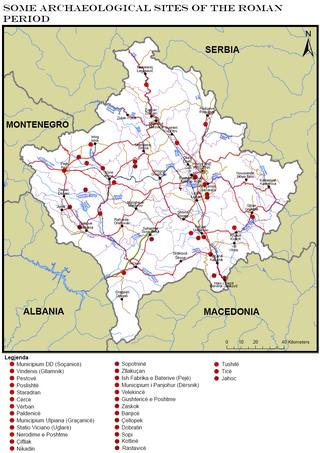
Municipium Dardanorum or Municipium Dardanicum was a Roman mining town whose life lasted from the 2nd to the 4th century AD, that was connected with the workings of. Its remains are situated in the northern part of Kosovo, located approximately 27 kilometres north of Mitrovica, about 65 km northeast of Ulpiana in the Municipality of Leposavic, localized in the village of Sočanica in the province of Moesia Superior, later the Roman province of Dardania.

Part of a series of articles upon Archaeology of Kosovo
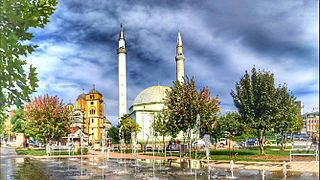
Ferizaj or Uroševac, is a city and a municipality in Kosovo. It is the sixth largest city in Kosovo by population and also the seat of Ferizaj Municipality and the Ferizaj District.
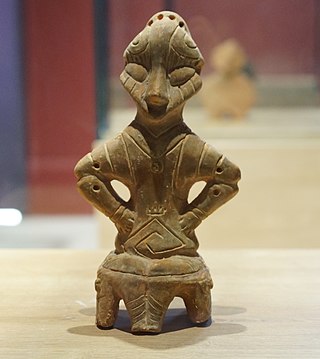
Goddess on the Throne (Albanian: Hyjnesha në fron; figurine found at the site of the Tjerrtorja spinning mill in Pristina, the capital city of Kosovo, in 1956. The seated terracotta figure is a well-preserved specimen of small Neolithic plastic Vinca culture. It measures 18.5 cm high and is dated to 5700–4500 BC.

Archaeology of Kosovo as a field of study and research was started in the second half of the 20th century. Kosovo's field of archaeology has developed in tandem with the historical study, studies of ancient authors' sources, classic philological studies, theological data research, topographic studies and ground survey, analysis of toponyms, deciphering of epigraphic and historiographic data. First data about antique monuments in Kosovo, were documented from the end of the 19th until the beginning of the Second World War, a time period when Kosovo was visited by researchers, guides, and archaeologists such as: Evans, Boue, Hahn, Kanitz, Tomaschek, Domaschevski, Arpad, Vulic, Jirecek, Patsch, Domenico Mustilli, etc.
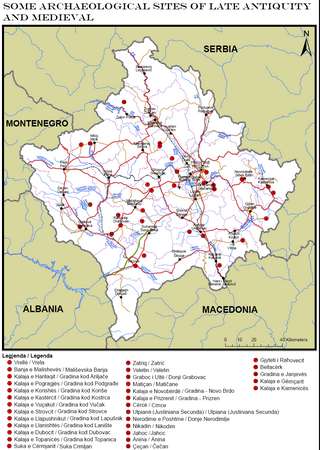
Part of series of articles upon Archaeology of Kosovo
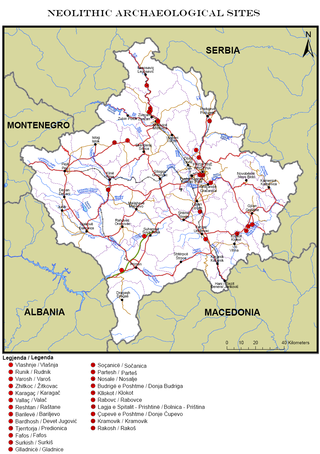
This is a description of Neolithic sites in Kosovo. The warm, humid climate of the Holocene which came soon after the ice melting of the last glacial period brought changes in nature which were reflected in humans, flora and fauna. This climatic stabilization influenced human life and activities; human society is characterized by changes in community organization and the establishment of permanent settlements in dry places, near riverbanks and on fertile plateaus.
Part of series of articles upon Archaeology of Kosovo

The Roman heritage sites in Kosovo represent a multitude of monuments of material and spiritual culture, which reflect the Roman period in this region. Among them, a special place is occupied by those that represent the development of art, such as the plastic monuments that are more frequent, and at the same time occupy an important place, because with the presentation of figures in relief and with numerous inscriptions they speak to us enough for this period.

Part of a series of articles upon Archaeology of Kosovo

Part of a series of articles upon Archaeology of Kosovo

Part of a series of articles on Archaeology of Kosovo

Part of a series of articles upon Archaeology of Kosovo

The Fortress of Harilaq is situated on top of the hill known by the local toponymy as the Gradina – Harilaq, set in an elevated and dominant position, west from the Harilaq village. The fortress is located in an altitude of maximum 766 metres above sea level, and is approximately sited 9 km southeast from the town of Kosovo Polje and only 2 kilometres west from Pristina International Airport "Adem Jashari".
Vlashnjë is a village in the Prizren municipality of Kosovo. It has 1,700 inhabitants as of 2011. Vlashnjë is a multi-layered settlement and site area. Archaeological excavations have identified habitation and use of the area since the Neolithic era. The rock art paintings at Mrrizi i Kobajës are the first find of prehistoric rock art in Kosovo. In late antiquity, Vlashnja was a fortified settlement part of the fortification network which Justinian I rebuilt along the White Drin in Dardania.
The strategic position of the region of Mitrovica in the middle of two great rivers Ibar and Sitnica and its mineral wealth in Albanik, made this location populated since prehistoric period. This region was populated by Illyrians, respectively members of the Dardan tribe. The first data for the archaeological sites in the region of Mitrovica, begin with the researches of Sir Artur John Evans, who was the first to pinpoint the Roman town of the Municipium Dardanourm. In the archaeological sites of the region of Mitrovica were found traces and objects from different periods such as; Neolithic, Roman, late antiquity and medieval period. Objects and figurines include: fortress vestiges, necropolis, Terpsichore figure, statues, sarcophagus, altar, jewelry, etc.

Duboc Fortress is situated above the Ceçan, part of the Ciçavica mountain chain, in the village of Duboc, approximately 10–12 km in the south-west of the Municipality of Vushtrri.














